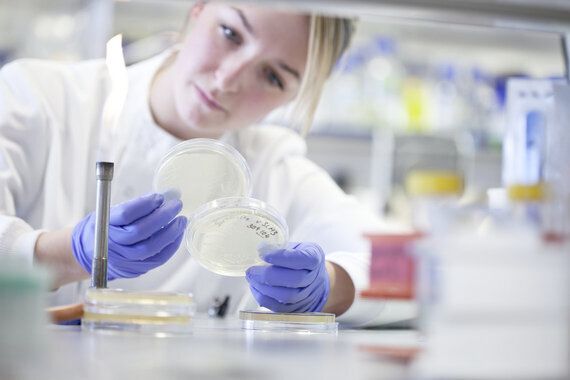When cancer research hits the headlines it's usually to announce the latest big breakthrough. With cancer affecting so many of us, the media know we are desperate for any new information that genuinely offers hope.
Unfortunately, far too often those headlines take a great piece of science and sell it as if it will single-handedly solve the cancer problem. Last week I was asked to comment on a 'universal cancer vaccine' being developed by a group of scientists in Germany. This made for an exciting headline, but the trial they conducted was only in three people. It's still amazing how many years of research it takes even to get to that very early stage.
A halo of press announcements always surrounds the big international cancer research conferences, most recently, the American Society of Clinical Oncology ASCO conference in Chicago wrapping up this week and the Association of American Cancer Research meeting held in New Orleans in April. At both gatherings immunotherapy was hailed as a potential method of treatment against several different cancers.

There continue to be huge strides being made in our understanding of cancer, as demonstrated by the great stories that come out of these conferences. Cancer medicine seems to be on the cusp of a revolution that will benefit us all. This is especially important now with statistics showing that half of us will receive a cancer diagnosis at some point in our lives.
But there is so much more to the scientific process than meets the eye. I want to pause to acknowledge some of our less publicly celebrated science: the scientists who work behind the headlines to make the everyday doing of research quicker and easier. (Don't worry. I'm getting to the lasagne analogy eventually.)
I started my PhD research before the human genome had been fully sequenced, so investigating a previously unstudied bit of human DNA meant first isolating it and then and sequencing it. The section of DNA I wanted to study was immediately next to a gene that had already been sequenced.
That particular gene's sequence had already been published by a scientist in the Netherlands so in theory I could anchor myself in the known sequence and do an experiment to 'walk' into the unknown bit and fish it out. But months later I was still walking, with no new fragment of DNA to show for it. I just couldn't get the technique to work and I had no idea why.
Happily for me and my scientific career, the first rough draft of the human genome was published online in June 2000. It took just thirty minutes at my desk to download the sequence of the stretch of DNA I was looking for. It turned out that the sequence was unusually gnarly. It had lots of repeat sequences and my experimental difficulties were caused by it 'sticking' to itself like a misbehaving piece of cling film. After months of fruitless slog in the lab, in the time it took me to drink a cup of tea I had suddenly acquired the knowledge I needed to move my project on. All thanks to a colossal multi-national investment of cash, time and scientific ingenuity to produce a resource for millions of researchers across the world.
OK, so the human genome project is actually a rather high profile example of how a new scientific resource accelerates research, but there are many more that don't make the front page.
In the area I trained in - molecular biology - I think of the bread-and-butter reagents (chemicals) and equipment used every day to isolate and manipulate DNA, to measure the activity of genes and proteins, to dissect the interactions of molecules within a cell. And I think about how, 15 years ago when I was doing my PhD, I could study a handful of genes in one experiment but now there are high throughput technologies that allow the study of thousands. Through technological advance, the pace of science quickens.
So who is producing this technology? Scientists, obviously, but who and where? Here we get to our unsung heroes. When you work in a laboratory it is easy to take for granted the availability of snazzy machinery and the ability to buy off-the-shelf reagents for almost everything. Want to purify some DNA? Edit a gene? Watch cells divide? There's technology for it and you can order it online.
Let me explain why this is important through the medium of lasagne. I love homemade lasagne, it's delicious and nutritious and a complete meal in itself. But it's a bother to make. There's the cooking of the meaty filling on the hob, the white sauce that you can't step away from, the grated knuckles and cheese all over the worktop, the lengthy baking in the oven. Imagine if instead a professional chef did all that fiddly prep work for you and delivered everything to your house in neat little packets so you just need to assemble it in your dish and pop it in the oven. Well, it's a bit like that, only in this analogy the chef designed the oven too.
Most of us probably imagine scientists doing blue sky research in universities or perhaps in pharmaceutical companies making and testing drugs. But behind the scenes there are thousands of scientists working in biotechnology, many in the commercial sector, dreaming up tools for other scientists to use in their pursuit of answers. Machines to automate and upscale, gizmos that make the scientific process itself more efficient and more reproducible so that answers arrive faster.
I certainly didn't appreciate the efforts of those scientists enough when I worked in the lab so I'm putting right that failure now. The scientific ecosystem reaches far and wide, into niches that aren't apparent on the surface of the latest discovery.
So when we see the next 'giant leap forward in cancer research' headline, perhaps we can take a pause to appreciate there's more to that discovery than meets the eye.